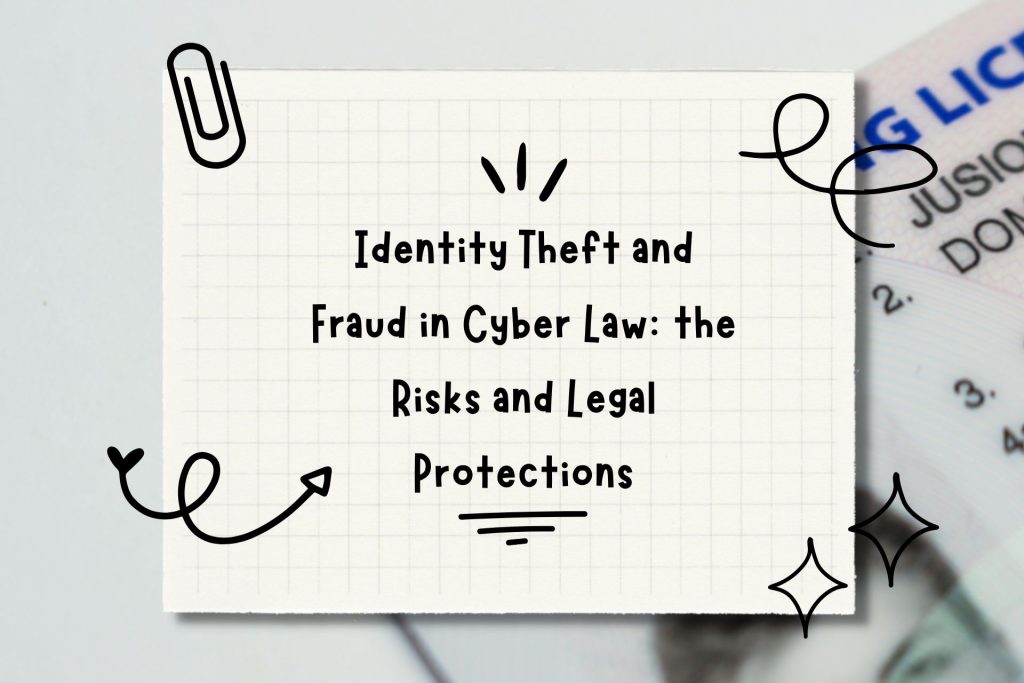As technology evolves, so do the tactics employed by cybercriminals to pilfer personal data and perpetrate fraudulent activities.
Identity theft entails the unauthorized use of an individual’s personal details, such as their name, Social Security number, or credit card information, for fraudulent purposes or other illicit activities.
Cybercriminals employ a variety of methods, including phishing scams, malware, and social engineering ploys, to obtain this information.
In the United States, the Computer Fraud and Abuse Act (CFAA) serves as the principal federal statute addressing cybercrime, encompassing identity theft and fraud.
The CFAA prohibits the intentional unauthorized access of a computer or exceeding authorized access, which encompasses the theft of personal information or its use in fraudulent activities.
Furthermore, the Identity Theft and Assumption Deterrence Act (ITADA) criminalizes the knowing transfer or use of another person’s identification without lawful authority.
As technology usage continues to surge, so does the prevalence of identity theft and fraud. It is now more critical than ever to take proactive measures to safeguard personal information and remain vigilant against cyber threats.
Understanding the legal framework surrounding cybercrime, such as the CFAA and ITADA, is pivotal in both thwarting and prosecuting these offenses.
Defining Identity Theft and Cyber Fraud

Identity theft is a type of cybercrime that involves stealing someone’s personal information, such as their name, address, Social Security number, or credit card number, with the intent to commit fraud. Cyber fraud is a broader term that encompasses various types of online scams and fraudulent activities, including phishing, spoofing, and hacking.
Identity theft and cyber fraud are becoming increasingly common in today’s digital age. According to the Federal Trade Commission (FTC), there were over 4.7 million reports of fraud and identity theft in 2020, with losses totaling over $3.3 billion [1]. These crimes can have devastating consequences for victims, including financial loss, damage to credit scores, and emotional distress.
Legal Frameworks Against Identity Theft
To combat identity theft and cyber fraud, there are various legal frameworks in place at both the federal and state levels. The Identity Theft and Assumption Deterrence Act, for example, makes it a federal crime to knowingly transfer or use someone’s personal information with the intent to commit fraud [2]. Additionally, many states have enacted their own laws to protect against identity theft and impose penalties on perpetrators.
In Nigeria, identity theft and fraud are considered serious offenses under cyber law. The Nigerian government has taken steps to address these issues by enacting legislation and implementing penalties for those found guilty of such crimes.
The Cybercrime Bill, which was approved by senators in Nigeria, criminalizes various online criminal activities, including identity theft and hacking government computers. Offenders can face imprisonment for up to seven years or a fine of up to seven million Nigerian naira (approximately $350,000) .
The Cybercrimes Act, 2015, in Part III, specifically addresses identity theft and impersonation as offenses. It criminalizes the unauthorized use or transfer of someone’s means of identification without lawful authority. The Act also covers other computer-related offenses and spells out the penalties for each offense .
Under the Cybercrime Act, hackers who unlawfully access computer systems or networks can face a fine of up to N10 million or a term of imprisonment of up to five years, depending on the purpose of the hack. Internet fraudsters who send electronic messages or access and use data stored on computer systems can also face the same punishment .
It is worth noting that the Cybercrime Act, 2015, also makes provision for identity theft, with the punishment of imprisonment for a term of not less than three years or a fine of not less than N7 million, or both fine and imprisonment.
In addition to legal frameworks, there are also various measures that individuals can take to protect themselves against identity theft and cyber fraud. These include being cautious when sharing personal information online, using strong passwords and two-factor authentication, monitoring credit reports regularly, and being aware of common scams and phishing tactics.
Mechanisms of Identity Theft
Identity theft is a serious issue in the realm of cybercrime, and it can be carried out through a variety of mechanisms. Some of the most common mechanisms of identity theft are:
Phishing and Social Engineering
Phishing is a type of social engineering attack where cybercriminals use fraudulent emails, text messages, or phone calls to trick individuals into revealing sensitive information such as usernames, passwords, and credit card numbers. These attacks are often highly convincing, as they may appear to come from legitimate sources such as banks, social media platforms, or online retailers.
Malware and System Exploits
Malware is a type of malicious software that can be used to steal sensitive information from a victim’s computer or mobile device. Cybercriminals can use a variety of techniques to distribute malware, including email attachments, infected websites, and social media links. Once the malware is installed on a victim’s device, it can be used to monitor their activity, steal their personal information, and even take control of their computer or mobile device.
System exploits are vulnerabilities in software that can be exploited by cybercriminals to gain access to sensitive information. These exploits can be used to gain access to a victim’s computer or mobile device, steal their personal information, and even take control of their device.
Data Breaches and Information Leaks
Data breaches occur when cybercriminals gain unauthorized access to a company’s database and steal sensitive information such as usernames, passwords, and credit card numbers. Information leaks occur when sensitive information is accidentally or intentionally disclosed to unauthorized parties. Both data breaches and information leaks can result in significant harm to individuals, as their personal information can be used to commit identity theft and fraud.
In conclusion, cybercriminals use a variety of mechanisms to carry out identity theft and fraud, including phishing and social engineering, malware and system exploits, and data breaches and information leaks. It is important for individuals to be aware of these mechanisms and take steps to protect their personal information from cybercriminals.
Preventive Measures
Identity theft and fraud can have devastating consequences for individuals and organizations alike. To prevent such incidents from occurring, there are several preventive measures that can be taken.
Individual Security Practices
Individuals can take several steps to protect themselves from identity theft and fraud. Some of these measures include:
- Using Strong Passwords: Individuals should use strong passwords that are difficult to guess and update them regularly.
- Avoiding Phishing Scams: Individuals should be wary of emails or messages that ask for personal information and avoid clicking on suspicious links.
- Securing Personal Devices: Individuals should secure their personal devices with strong passwords and avoid using public Wi-Fi networks to access sensitive information.
- Monitoring Credit Reports: Individuals should regularly monitor their credit reports to detect any unauthorized activity.
Organizational Data Protection Policies
Organizations can also take several steps to protect themselves from identity theft and fraud. Some of these measures include:
- Implementing Access Controls: Organizations should implement access controls to restrict access to sensitive information to authorized personnel only.
- Conducting Regular Security Audits: Organizations should conduct regular security audits to identify vulnerabilities and address them promptly.
- Providing Employee Training: Organizations should provide regular training to employees on best practices for data protection and security.
- Encrypting Sensitive Data: Organizations should encrypt sensitive data to prevent unauthorized access in case of a security breach.
By implementing these preventive measures, individuals and organizations can significantly reduce their risk of falling victim to identity theft and fraud.
Legal Recourse and Enforcement
Identity theft and fraud are serious crimes that can cause significant harm to individuals and organizations. Fortunately, there are legal remedies available for victims of these crimes.
Reporting Identity Theft
The first step in seeking legal recourse for identity theft is to report the crime to law enforcement. Victims can report the crime to their local police department or to the Federal Trade Commission (FTC). The FTC maintains a database of identity theft cases that can be used by law enforcement agencies to investigate and prosecute identity thieves.
When reporting identity theft to law enforcement, victims should provide as much information as possible about the crime, including any evidence they have of the theft. This can include copies of credit reports, bank statements, and other financial records.
Investigation and Prosecution Processes
Once a victim reports identity theft to law enforcement, the investigation process begins. Law enforcement agencies will work to identify the perpetrator of the crime and gather evidence to support prosecution. This can include interviewing witnesses, reviewing financial records, and analyzing digital evidence.
If the investigation leads to the identification of a suspect, the case will be referred to a prosecutor for prosecution. Prosecutors will review the evidence gathered by law enforcement and determine whether there is enough evidence to support a criminal case.
If a suspect is charged with identity theft or fraud, they will have the opportunity to defend themselves in court. If convicted, they may face significant penalties, including fines, restitution, and imprisonment.
Emerging Trends and Future Challenges
As technology advances, so do the tactics used by fraudsters to commit identity theft. Cyber law must keep up with these advancements to ensure that individuals and companies are protected from financial cybercrime. In this section, we will explore two emerging trends in cyber law that are shaping the future of identity theft and fraud prevention.
Advancements in Digital Identity Verification
One of the most promising trends in cyber law is the advancement of digital identity verification. With the rise of biometric authentication, such as facial recognition and fingerprint scanning, digital identity verification has become more secure and efficient. These technologies can help prevent identity theft by ensuring that only authorized individuals can access sensitive information.
In addition to biometric authentication, blockchain technology is also being used for digital identity verification. Blockchain provides a secure and decentralized method of storing and verifying identity information, making it more difficult for fraudsters to steal personal information.
Impact of New Technologies on Cyber Law
As new technologies emerge, cyber law must adapt to address the new challenges they present. For example, the increasing use of artificial intelligence (AI) in financial transactions has created new opportunities for fraudsters to exploit. AI can be used to automate fraudulent activities, making it more difficult for traditional fraud detection methods to detect and prevent these activities.
Another emerging technology is the Internet of Things (IoT), which refers to the interconnected network of physical devices such as smartphones, home appliances, and vehicles. The IoT presents new challenges for cyber law, as these devices can be used to collect and transmit sensitive information. As the number of IoT devices continues to grow, cyber law must adapt to address the new security risks they present.
Conclusion
Emerging trends in digital identity verification and the impact of new technologies on cyber law present both opportunities and challenges in the fight against identity theft and fraud. By staying up-to-date with these trends and adapting to new challenges, cyber law can continue to protect individuals and companies from financial cybercrime.





